Why KNX with Matter is the best smart home you can build right now

What does a good smart home system need?
So you are looking to build a smart home and you are trying to find the best system that would fit your needs and your budget.
While there are many options to choose from, not all of them are equally good or equally future-proof.
First, you need to understand what factors are important when choosing your smart home system:
- Reliability - A smart home should work at all times without any problems. Wired smart homes are way more reliable than wireless IoT solutions. While having a wired smart home system is not always possible, some wireless solutions can also serve as a good alternative. (More on that: https://youtube.com/shorts/vixzVP0FQDE?feature=share)
- Future-proofing - When you want to add or change something after 10 years, the technology should not only still be around, but also be up to date with all the new advancements.
- Longevity of devices - Imagine having 50+ smart home devices in your home and having to change them every 5 years. Smart home devices should last for decades.
- Openness - Smart home market is still new and ever-changing. If your system is not open but instead controlled by only one company, you are completely locked in with whatever this company thinks is right. With an open system, you get to choose.
- Ability to adjust automation and settings yourself - Your life changes with time and so should your smart home. Make sure to select a system that gives you the ability to adjust and create new automation yourself, without the help of an integrator.
- A modern user experience - In the 2020s you shouldn’t be satisfied with an interface that looks like it was made in 2005.
- Ability to easily extend the system - Smart homes evolve, and will keep evolving. You should be able to add new devices yourself at least to some extent.
- Professional support ecosystem - Having plenty of smart home integrators around to help you out when needed is a must-have. For most people, installing and maintaining everything themself is too technical and time-consuming.
Unfortunately, not many systems cover all or even most of that.
Most smart home systems are not ready to power your home
While there are hundreds of different smart home systems, you can in general split them into two types: Wired and wireless smart home systems, each with its own pros and cons.
Wireless (IoT) systems
Pros:
- Modern UI
- Ability to add new devices and change automation yourself
- Plug and play
Cons:
- Not completely reliable due to inherent limitations of current wireless technologies
- No real professional support ecosystem. You need to do everything by yourself.
- These devices are gadgets. The lifetime is often less than 5 years.
- Questionable long-term support. The devices might quickly become unsupported.
*It has to be noted that there is a lot of improvement to be expected with the release and maturing of the Matter protocol
Wired (professional) systems
Pros:
- Completely reliable
- Devices last for 20+ years
- Professional network of smart home integrators to install and maintain your system
- Works well with hundreds of devices in one home
Cons:
- Many of those systems are proprietary and controlled by a single company. This can be a large risk for an investment that should last decades. Make sure you are in the hands of an ecosystem that can still be around in 15 years and is not controlled by a single company (e.g. KNX).
- You need an integrator to change every little thing after you move in which can get quite expensive.
- Many mobile apps usually look like they were designed decades ago (because they actually were made decades ago).
To make the best possible investment, you need to choose a smart home system with as few cons and as many pros as possible.
Which system to choose?
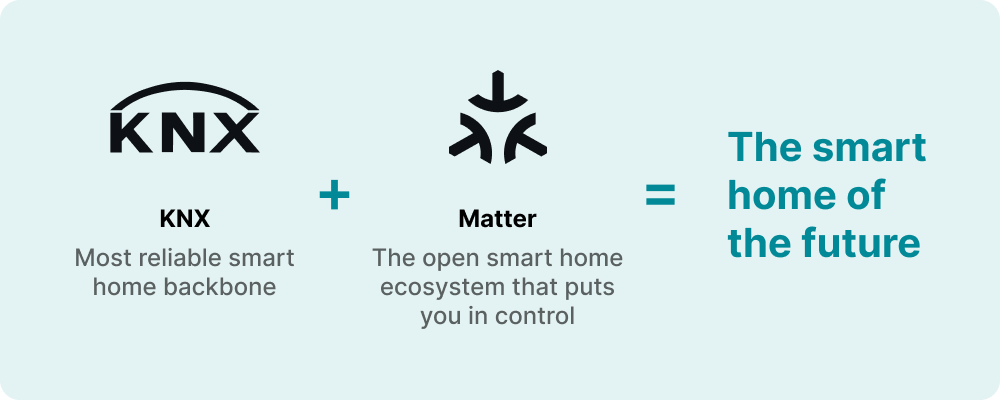
It turns out that you get the best smart home system if you combine the best two systems of both IoT and professional smart home worlds into one.
This way you can get the best of both worlds without increasing the cost of your smart home.
We have worked with many smart home systems of all kinds in the past years. It is clear, however, which systems are the best in wireless (modern) and which in professional smart home markets. These systems are:
- KNX - Is a German-based professional smart home system that is completely open, used in over 2 million installations, and supported by over 500 world-renowned manufacturers. It is the best solution for everyone concerned about quality, stability, privacy, and future-proofness.
- Apple Home (via Matter, or any other Matter compatible apps such as Google Home, Alexa, SmartThings, ...) - It's the smart home ecosystem with a way better user experience than anything else currently on the market. It is also a system that puts you in complete control of your smart home and lets you do most of the things by yourself, such as letting you set up all kinds of custom automation or add additional wireless devices. If you integrate KNX via Apple Home through the new open smart home standard Matter (using our new 1Home Server device), you can also use other smart home apps to control your home, such as Google Home, Samsung SmartThings, Amazon Alexa, Home Assistant - all interchangeably and at the same time. Matter is the new open standard that all of the above companies have decided to use as their base communication layer for their smart home apps. Which makes it the most future-proof smart home standard besides KNX.
Let’s explain more about each system in the following sections.
What is KNX?
KNX in its essence is an open standard for building automation with the highest possible focus on the quality and longevity of the devices.
With origins in Germany, it is one of the most, if not the most, used building automation standards in the world.
Being open means that any company can create smart home products for it which makes it incredibly versatile and powerful.
There are over 500 high-profile manufacturers making 20000+ mostly wired smart home products that can seamlessly communicate with each other. Basically, any smart home use case is covered.
Some of the main benefits of KNX are:
As reliable as it gets
KNX is mostly a wired system and can also be described as a more advanced electrical installation, made for modern buildings. Besides in residential homes, KNX is also used in airports, hospitals and other critical infrastructure. It was designed to be as stable as possible and it ensures that if any device fails, other parts of the system will continue to work uninterruptedly.
You can easily control hundreds of devices in your home with KNX and it will still work without any problems whatsoever.
An open standard keeps the options open
KNX is an open standard, which means that anyone can develop new products for it. Many other closed smart home systems are controlled by only one company and if anything happens to it or the company doesn't want to support a device you wish to integrate, you are out of luck. With KNX anyone can extend it, which keeps all the options open for the future.
A large ecosystem of 500 manufacturers and around 10.000 integrators in Germany alone (around 100.000 worldwide)
With this many manufacturers creating KNX-compatible products, the system is unmatched in the number of different devices you can connect to it. If you want a device to control something, you can choose from tens of different manufacturers each with its own different qualities. And many of the products are from German companies, made in Germany. With such a large number of certified integrators, you can find one almost anywhere in the world.
Unmatched longevity
KNX devices are built with the goal to last for decades while new devices always stay compatible with the old ones. With this many manufacturers developing new products, you can be sure that almost any new technology will be supported in the future.
KNX installation normally looks a bit like this:

KNX offers support for almost any kind of device:
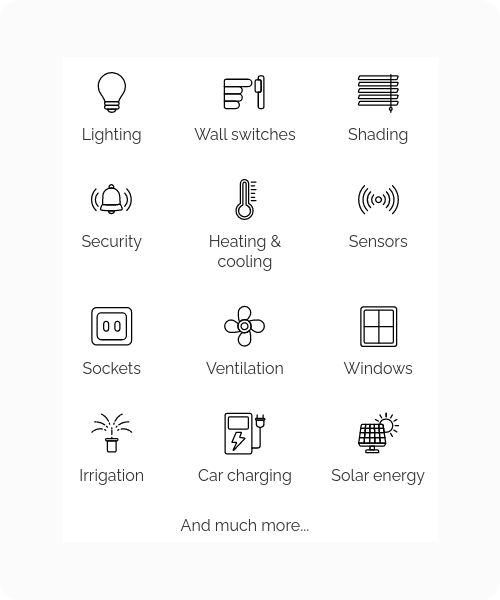
Control your home with smart wall switches
To control your smart home, you can choose from a plethora of smart wall switches that are compatible with KNX and can control almost anything in your home, from lights, blinds, heating, music, scenes, air conditioning and anything else you can think of. While still having your grandparents use it the same way they are used to.
Or use your traditional switches and make them smart
If you fancy traditional wall switches, KNX has you covered. You can use any traditional wall switch to control your home.
By combining KNX with a smart home app (Apple Home, Google Home, Amazon Alexa, Samsung SmartThings) via Matter, you give this time-tested technology a modern look and experience.
What is Matter?
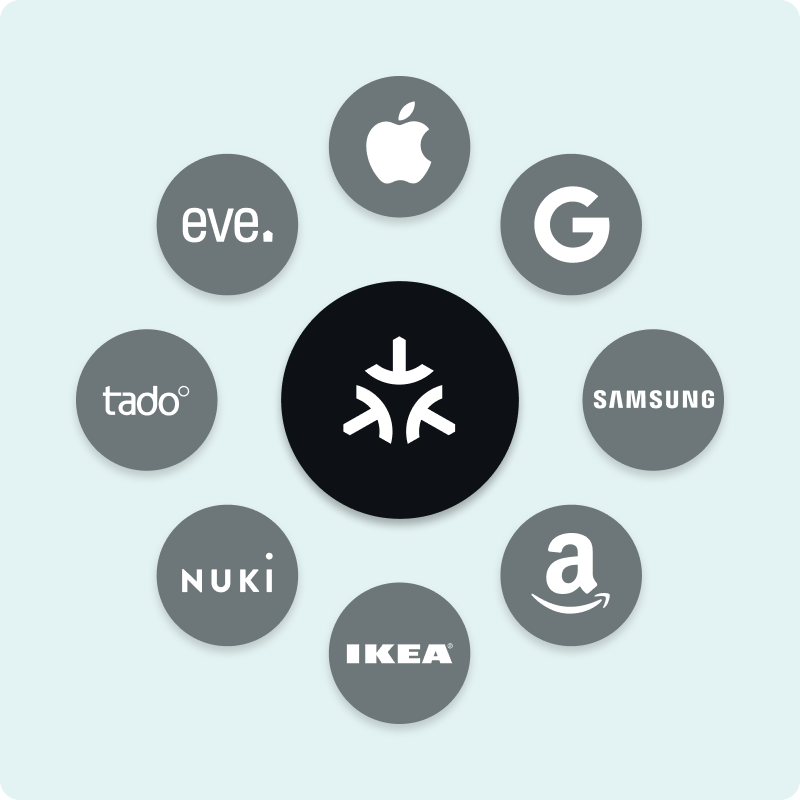
Matter is a smart home connectivity standard that was chosen by all the largest smart home companies as the standard of the future. This is a big deal, as this has never been achieved before - a whole industry deciding to use the same smart home standard. Matter is based on the Internet Protocol (IP). This means that Matter devices can communicate with each other over Wi-Fi, ethernet, or Thread, which is a low-power wireless protocol that was designed particuarly for smart home devices.
Matter also works completely locally, so to integrate it the device manufacturers don't require any cloud connection. No internet, no problem.
It offers Interoperability
Matter devices are be able to work together regardless of their manufacturer, which makes it easier for users to create a cohesive smart home system.
It is secure
Matter devices are more secure than current smart home devices, thanks to features like encryption and authentication.
It is simple to set up and use
Matter is designed to be simple to use, both for developers and for end users.
Matter is not a standard that will quickly fade - it’s here to stay, also proven by some of the biggest smart home players that have already committed to supporting it: Apple, Google, Amazon, Samsung, IKEA, Zigbee Alliance, and more.
Matter app example: Apple Home
Apple Home is an official smart home ecosystem developed by Apple. It boasts a slick and well-thought-out user experience - just what is expected from Apple. It is by far the most polished and reliable IoT smart home ecosystem.
Apple Home is built out of two parts: an iOS app to control your smart home named Apple Home, and a backbone system that lets you connect Apple Home-certified smart home devices, create custom automation, and control your home. The backbone is using new open standard Matter for communication with smart devices, most of which can be from your KNX smart home.
It also enables you to control your smart home with Siri voice commands. You can, for example, control your lights by simply saying “Hey Siri, turn off all Kitchen lights”.
This is what the Apple Home app looks like:
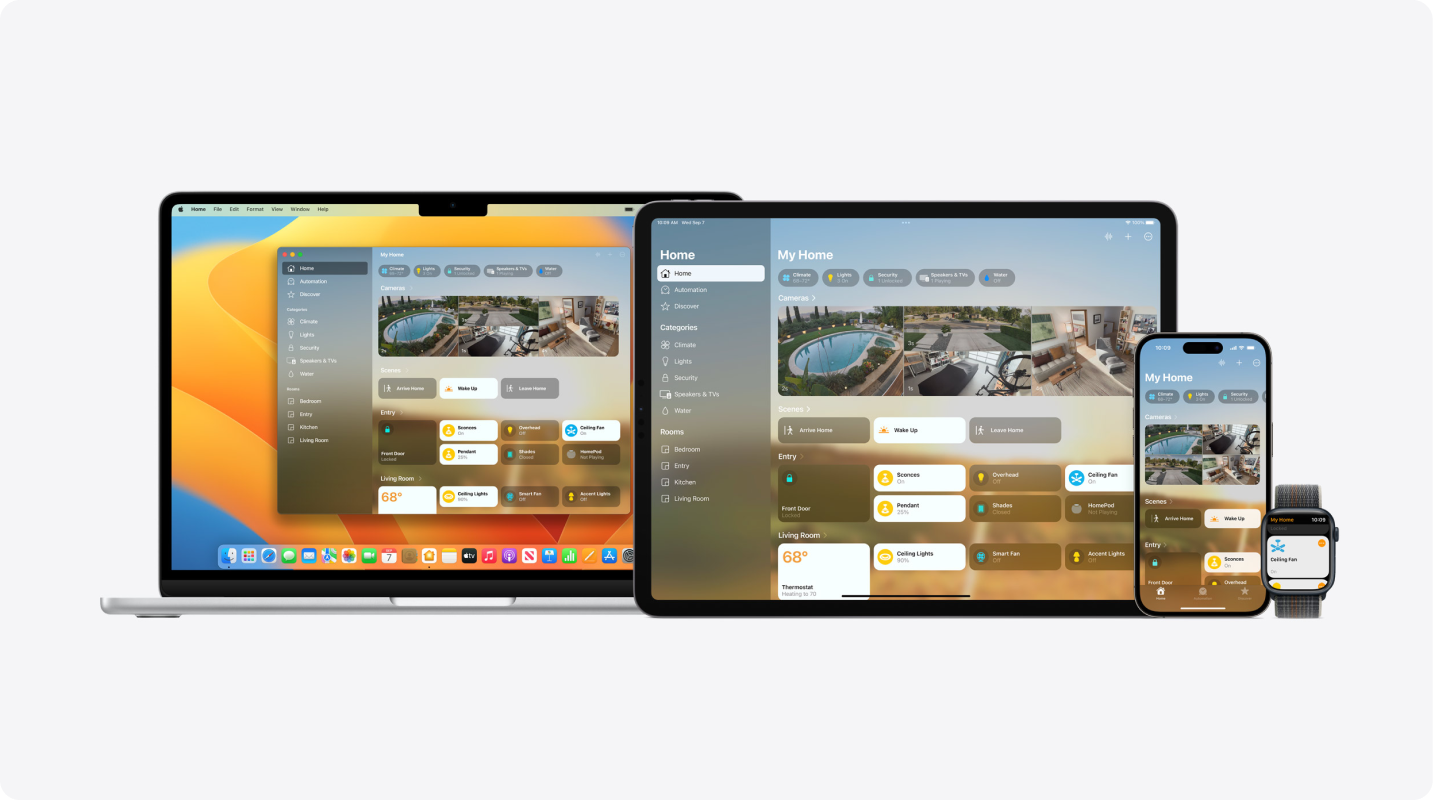
Apple also integrates many high-quality brands that you can use in your smart home that are not as well covered in KNX, such as:
- SONOS (via Airplay)
- Eve
- Tridonic
- Nanoleaf
- Aquara
- Comcast
- Sengled
- Yeelight
- TP-Link
- Tapo
- Onvis
- …
In other words, Apple Home gives you by far the best experience of controlling and interacting with your smart home. Apple is also adding new features with every major iOS release, while new Home certified devices get released almost on a daily basis. And the best part? You can install most of those devices yourself.
If you combine Apple Home (or other smart home apps) via Matter with KNX and control robust and high-quality KNX devices with it, you just got yourself a powerful yet modern smart home.
How do these systems work together?
Integrating KNX and smart home apps via Matter into a single system is simple and seamless. We’ll be using Apple Home as an example, but you can also use Google Home, Amazon Alexa, or Samsung SmartThings.
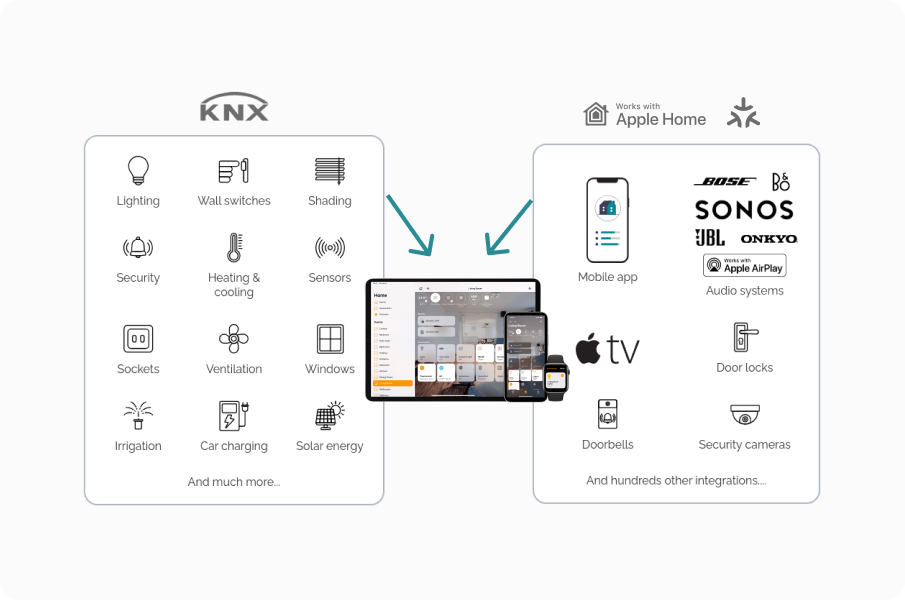
KNX - KNX serves as a reliable backbone of your system. It controls your lights, blinds, heating, wall switches, sensors such as motion, temperature, brightness sensors, and similar mission-critical devices. KNX will make them as reliable as a classical electrical installation. A rule of thumb is to use KNX to control all devices that must work at all times and should last for decades.
Apple Home (or any other Matter-supported mobile app) - Use it as a control center of all your KNX and non-KNX devices. With this, you get a modern way to control your home and create different automation combining every device in your home. Within Apple Home, you won’t even notice which devices come from KNX and which do not, it is that seamless.
Why this combination is future-proof?
Matter mobile apps and KNX cover all the aspects of future-proofness:
Keeping up to date
KNX - With 500 world-renowned manufacturers supporting the standard, new highly reliable KNX devices are constantly being released.
Apple Home (or other mobile apps via Matter) - Apple is one of the largest innovators in the smart home market. All the new cool features will be supported here.
Longevity
KNX - has been used in residential homes and in mission-critical industry infrastructure for the past 30 years. It is completely rooted in our society and it is here to stay.
Apple Home (or other mobile apps via Matter) - When Apple commits to a product or a market it means that it is a part of their larger long-term vision. Smart homes are no different.
Customization
KNX - For each type of smart device, many alternative options by different companies can be found.
Apple Home - Besides Apple Home, Matter enables you to also use other smart home apps such as Google Home, Samsung SmartThings, Amazon Alexa, Home Assistant, and others.
By creating your smart home with KNX as a backbone and Apple Home as your interface and control center, your smart home future is in safe hands.
1Home Server makes it happen
The best way to install such a smart home is to combine KNX and Apple Home via our 1Home Server device through Matter. 1Home Server locally connects KNX to the Matter smart home standard, which is used by Apple Home, Google Home, Samsung SmartThings, Amazon Alexa - which can all be used to control your home.

Get your 1Home Server here.
